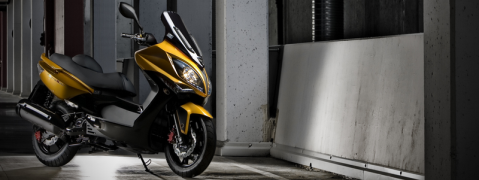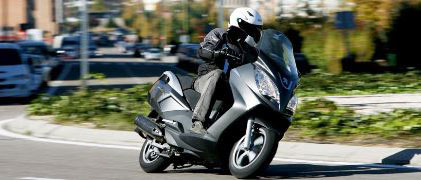 Kawasaki J300 - Service manual > ABS Servicing Precautions
Kawasaki J300 - Service manual > ABS Servicing Precautions
There are a number of important precautions that should be followed servicing the ABS system.
- This ABS system is designed to be used with a 12 V sealed battery as its power source. Do not use any other battery except for a 12 V sealed battery as a power source.
- Do not reverse the battery cable connections. This will damage the ABS hydraulic unit.
- To prevent damage to the ABS parts, do not disconnect the battery cables or any other electrical connections when the ignition switch is on or while the engine is running.
- Take care not to short the leads that are directly connected to the battery positive (+) terminal to the chassis ground.
- Do not turn the ignition switch on while any of the ABS electrical connectors are disconnected.
- Do not spray water on the electrical parts, ABS parts, connectors, leads and wiring.
- If a transceiver is installed on the motorcycle, make sure that the operation of the ABS system is not influenced by electric wave radiated from the antenna. Locate the antenna as far as possible away from the ABS hydraulic unit.
- Whenever the ABS electrical connections are to be disconnected, first turn off the ignition switch.
- The ABS parts should never be struck sharply, as with a hammer, or allowed to fall on a hard surface. Such a shock to the parts can damage them.
- The ABS parts cannot be disassembled. Even if a fault is found, do not try to disassemble and repair the ABS parts, replace it.
- The ABS has many brake lines, pipes, and leads. And the ABS cannot detect problems with the conventional braking system (brake disc wear, unevenly worn brake pad, and other mechanical faults). To prevent trouble, check the brake lines and pipes for correct routing and connection, the wiring for correct routing, and the brakes for proper braking power. Be sure to check for fluid leakage, and bleed the brake line thoroughly.
WARNING Air in the brake lines diminish braking performance and can cause an accident resulting in injury or death. If the brake lever has a soft or "spongy" feeling mushy when it is applied, there might be air in the brake lines or the brake may be defective. Do not operate the vehicle and service the brake system immediately.
NOTICE Do not ride the motorcycle with air in the brake line, or the ABS could malfunction.
- The Yellow ABS indicator light (LED) [A] may light if the tire pressure is incorrect, a non-recommended tire is installed, or the wheel is deformed. If the indicator light lights, remedy the problem.
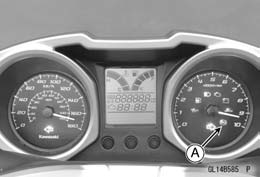
WARNING Use of non-recommended tires may cause malfunctioning of ABS and can lead to extended braking distance resulting in an accident causing serious injury or death. Always use recommended standard tires for this motorcycle.
- The yellow ABS indicator light (LED) may come on if the engine is run with the motorcycle on the center stand, and the rear wheel turns.
- When the ABS operates, the ABS makes noise and the rider feels the reaction force on the brake lever.
- Before delivering the motorcycle to the customer, test run the motorcycle at a speed of more than 20 km/h (12 mph) to see that the yellow ABS indicator light (LED) does not come on. Finally, test run the motorcycle at a speed of more than 30 km/h (20 mph) and brake suddenly to see that the motorcycle stops without loss of steering control and the ABS operates normally (The reaction force generated is felt in the brake lever and pedal.). This completes the final inspection.
ABS Troubleshooting Outline
Even when the ABS is operating normally, the yellow ABS indicator light (LED) may light up under the conditions listed below. Turn the ignition switch off to stop the indicator light.
If the motorcycle runs without remedying the problem, the light may light up again.
- After continuous riding on a rough road.
- When the engine is started with the center stand raised, and the rear wheel turns.
- When accelerating so abruptly that the front wheel leaves the ground.
- When the ABS has been subjected to strong electrical interference.
- When tire pressure is abnormal. Adjust tire pressure.
- When a tire different in size from the standard size is being used. Replace with standard size.
- When the wheel is deformed. Replace the wheel.
Much of the ABS troubleshooting work consists of confirming continuity of the wiring. The ABS parts are assembled and adjusted by the manufacturer, so there is no need to disassemble or repair them. Replace the ABS hydraulic unit.
The basic troubleshooting procedures are listed below.
- Carry out the preliminary inspection.
- Carry out the general inspection.
- Check the wiring and connections from the ABS hydraulic unit connector to the suspected faulty ABS part, using a tester.
- Visually inspect the wiring for signs of burning or fraying.
If any wiring is poor, replace the damaged wiring.
- Pull each connector apart and inspect it for corrosion, dirt and damage.
If the connector is corroded or dirty, clean it carefully. If it is damaged, replace it.
- Check the wiring for continuity.
- Use the wiring diagram to find the ends of the lead which is suspected of being a problem.
- Connect the tester between the ends of the leads.
If the tester does not read about 0 О©, the lead is defective.
Replace the main harness if necessary.
- Narrow down suspicious parts and close in on the faulty ABS part by
repeating the continuity tests.
If no abnormality is found in the wiring or connectors, the ABS parts are the next likely suspects. Check each part one by one.
If an abnormality is found, replace the affected ABS part.
ABS Diagnosis Flow Chart
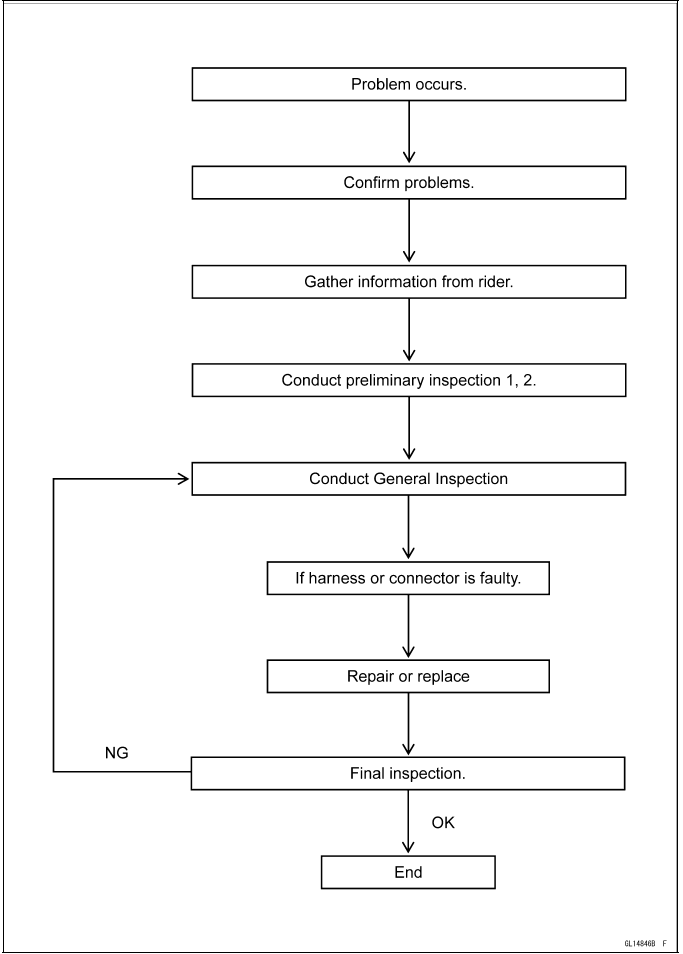
Inquiries to Rider
- Each rider reacts to problems in different ways, so it is important to confirm what kind of condition the rider is dissatisfied with.
- Try to find out exactly what problem occurs under exactly what conditions by asking the rider; knowing this information may help you reproduce the problem in the shop.
- The diagnosis sheet will help prevent you from overlooking any keys, so always use it.
Sample Diagnosis Sheet
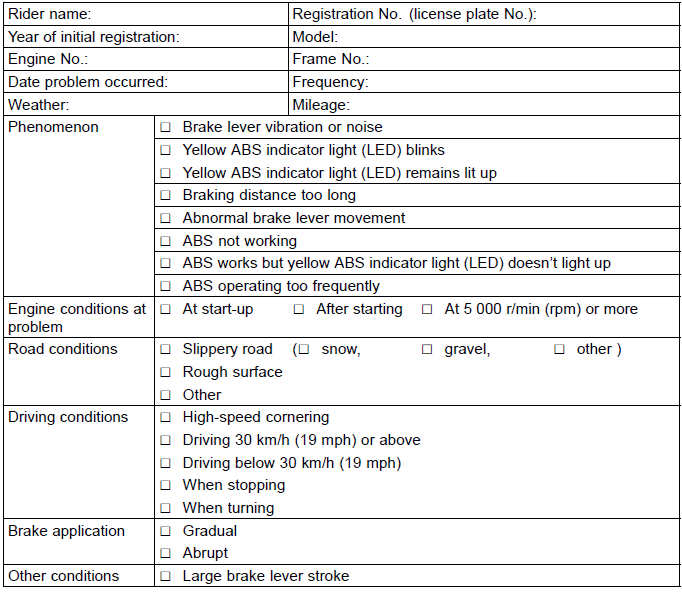
Preliminary Inspection 1
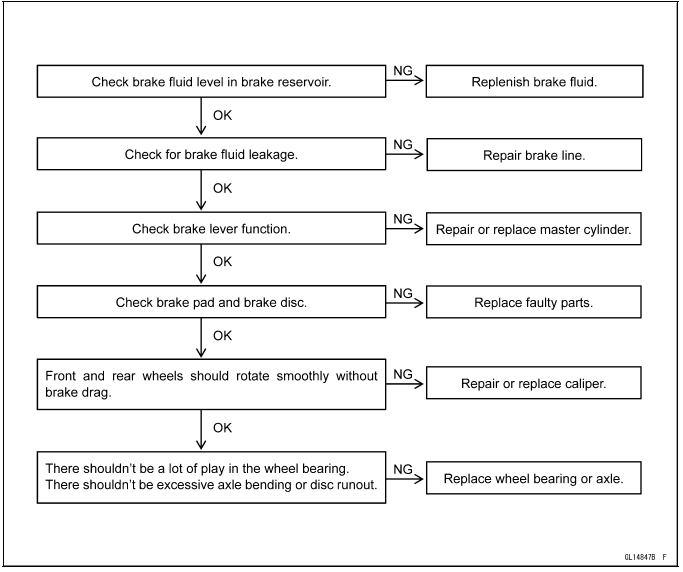
Preliminary Inspection 2
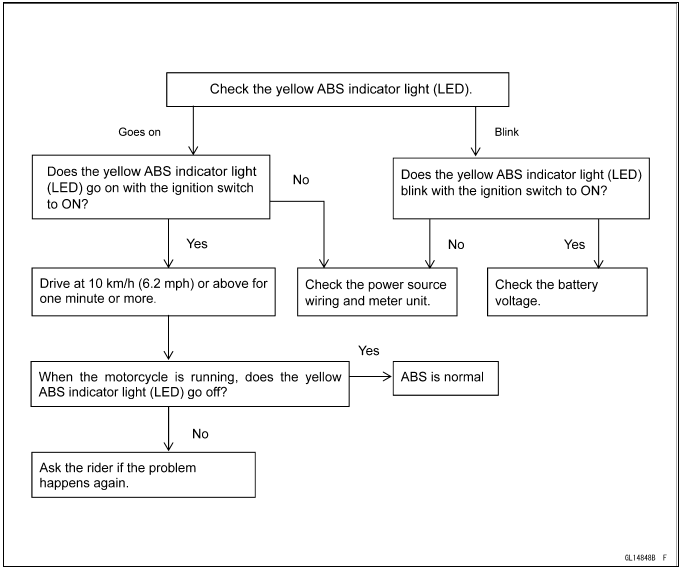
Yellow ABS Indicator Light (LED) Inspection
- In this model, the yellow ABS indicator light (LED) [A] goes on by the control of the ABS hydraulic unit.
- Refer to the meter operation Inspection in the Electrical System chapter.
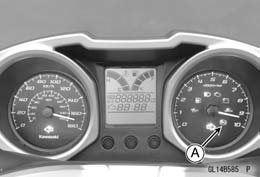
ABS Solenoid Valve and Relay Inspection
- Check the ABS solenoid valve relay fuse (25 A) [A] (see Fuse Inspection in the Electrical System chapter).
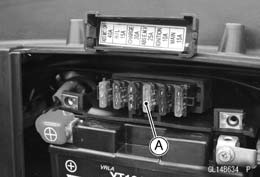
If the fuse is good, check the wiring continuity between the positive (+) terminal [A] of the battery and R/BK lead terminal [B] in the ABS Hydraulic Unit Connector [C].
- Disconnect the ABS hydraulic unit connector.
If the wiring is open, replace or repair the harness (see ABS System Wiring Diagram).
If the wiring is good, replace the ABS hydraulic unit.
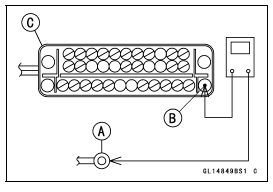
Front, Rear Wheel Rotation Difference Abnormal (Deviation between Wheel Speeds)
- Check the following and correct the faulty part.
Incorrect Tire Pressure
Tires not recommended for the motorcycle were installed (incorrect tire size).Deformation of Wheel or Tire
Missing Teeth and Clogging with Foreign Matter of Sensor Rotor (see Wheel Rotation Sensor Inspection)
ABS Motor Relay Inspection
- Check the ABS motor relay fuse (40 A) [A] (see Fuse Inspection in the Electrical System chapter).
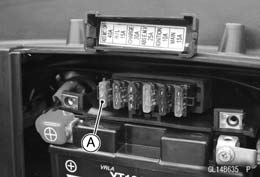
If the fuse is good, check the wiring continuity between the positive (+) terminal [A] of the battery and R/BK lead terminal [B] in the ABS hydraulic unit connector [C].
- Disconnect the ABS hydraulic unit connector.
If the wiring is open, replace or repair the harness (see ABS System Wiring Diagram).
If the wiring is good, replace the ABS hydraulic unit.
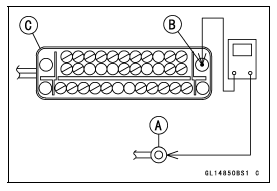
Wheel Rotation Sensor Signal Abnormal
- Measure the air gap between the wheel rotation sensor [A] and sensor rotor [B] (see Wheel Rotation Sensor Air Gap Inspection).
- Check the wheel rotation sensor (see Wheel Rotation Sensor Inspection).
If both inspections are good, go to the next step.
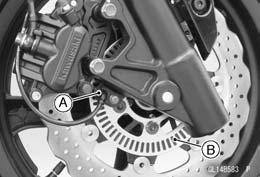
- Check that there is iron or other magnetic deposits between the sensor [A] and sensor rotor [B], and the sensor rotor slots for obstructions.
- Check the installation condition of the sensor for looseness.
- Check the sensor rotor tip for deformation or damage (e.g., chipped
sensor rotor teeth).
If the sensor rotor in bad condition, remove the any deposits.
Install the proper part or replace faulty part.
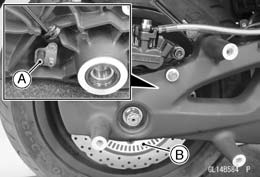
Front Wheel Rotation Sensor Wiring Inspection
- Disconnect:
ABS Hydraulic Unit Connector (see ABS Hydraulic Unit Removal)
Front Wheel Rotation Sensor Connector (see Front Wheel Rotation Sensor Removal) - Check the wiring continuity of the R/G lead and W/BR lead.
Front Wheel Rotation Sensor Lead Connector [A]
ABS Hydraulic Unit Lead Connector [B]
R/G Lead Terminal [C]
W/BR Lead terminal [D]
If the wiring is open, replace or repair the harness (see ABS System Wiring Diagram).
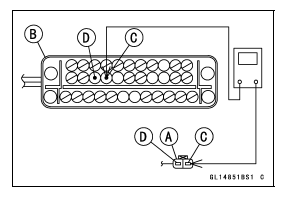
Rear Wheel Rotation Sensor Wiring Inspection
- Disconnect:
ABS Hydraulic Unit Connector (see ABS Hydraulic Unit Removal)
Rear Wheel Rotation Sensor Connector (see Rear Wheel Rotation Sensor Removal) - Check the wiring continuity of the BK/R lead and LG/BR lead.
Rear Wheel Rotation Sensor Lead Connector [A]
ABS Hydraulic Unit Lead Connector [B]
BK/R Lead Terminal [C]
LG/BR Lead terminal [D]
If the wiring is open, replace or repair the harness (see ABS System Wiring Diagram).
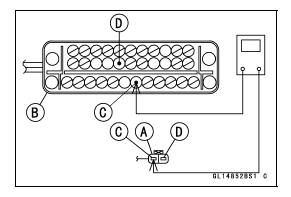
See also:
 Kawasaki J300 - Service manual > Parts Location
Kawasaki J300 - Service manual > Parts Location
Front Wheel Rotation Sensor [A] Front Wheel Rotation Sensor Rotor [B]
 Kawasaki J300 - Service manual > ABS Hydraulic Unit Removal/Installation
Kawasaki J300 - Service manual > ABS Hydraulic Unit Removal/Installation
ABS Hydraulic Unit Removal NOTICE The ABS hydraulic unit [A] has been adjusted and set with precision at the factory. Therefore, it should be handled carefully, never struck sharply, as with a hammer, or allowed to fall on a hard surface.




